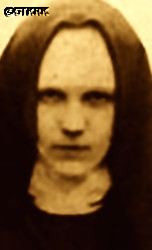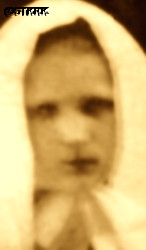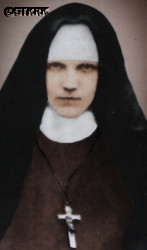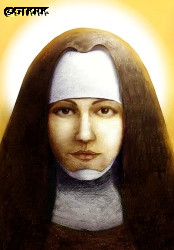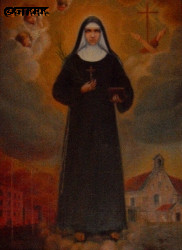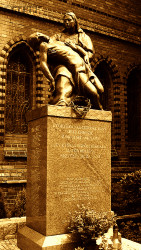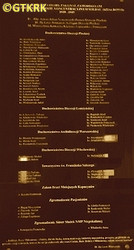Roman Catholic
St Sigismund parish
05-507 Słomczyn
85 Wiślana Str.
Konstancin deanery
Warsaw archdiocese, Poland
full list:
displayClick to display full list

searchClick to search full list by categories
wyświetlKliknij by wyświetlić pełną listę po polsku

szukajKliknij by przeszukać listę wg kategorii po polsku

Martyrology of the clergy — Poland
XX century (1914 – 1989)
personal data
religious status
blessed
surname
KOWALSKA
forename(s)
Mieczyslava (pl. Mieczysława)
religious forename(s)
Mary Therese of Baby Jesus (pl. Maria Teresa od Dzieciątka Jezus)
beatification date
13.06.1999more on
www.swzygmunt.knc.pl
[access: 2013.05.19]

the RC Pope John Paul IImore on
en.wikipedia.org
[access: 2014.09.21]
function
nun
creed
Latin (Roman Catholic) Church RCmore on
en.wikipedia.org
[access: 2014.09.21]
congregation
Order of Capuchin Poor Clares OSCCapmore on
en.wikipedia.org
[access: 2013.05.19]
(i.e. Capuchin Poor Clares)
diocese / province
Płock diocesemore on
en.wikipedia.org
[access: 2013.05.19]
date and place
of death
25.07.1941

KL Soldauconcentration camp
today: Działdowo, Działdowo urban gm., Działdowo pov., Warmia‐Masuria voiv., Poland
more on
en.wikipedia.org
[access: 2018.09.02]
details of death
After German and Russian invasion of Poland in 09.1939 and start of the World War II, after start of German occupation, arrested by the Germans on 02.04.1941 together with 36 nuns from their Congregation's house in Przasnysz.
Transported to KL Soldau concentration camp where she soon contracted tuberculosis and perished.
cause of death
extermination: exhaustion, starvation, disease
perpetrators
Germans
sites and events
KL SoldauClick to display the description, Ribbentrop‐MolotovClick to display the description, Pius XI's encyclicalsClick to display the description
date and place
of birth
19.09.1902Birth certification on:
metryki.genealodzy.pl
[access: 2025.03.01]

Warsawtoday: Warsaw city pov., Masovia voiv., Poland
more on
en.wikipedia.org
[access: 2021.10.09]
parents
KOWALSKI Adam Joseph
🞲 ?, ? — 🕆 ?, ?

BRZEZIŃSKA Valerie Constance
🞲 ?, ? — 🕆 ?, ?
baptism
05.10.1902Birth certification on:
metryki.genealodzy.pl
[access: 2025.03.01]

Warsawtoday: Warsaw city pov., Masovia voiv., Poland
more on
en.wikipedia.org
[access: 2021.10.09]
All the Saints RC church
religious vows
15.08.1924 (temporary)
26.07.1928 (permanent)
presbyter (holy orders)
ordination
01.01.1902

positions held
1924 – 1941
nun — Przasnysztoday: Przasnysz urban gm., Przasnysz pov., Masovia voiv., Poland
more on
en.wikipedia.org
[access: 2021.12.18] ⋄ monastery, Capuchin Poor Clares OSCCap — i.a. porter, sacristan, librarian
12.08.1923 – 15.08.1924
novitiate — Przasnysztoday: Przasnysz urban gm., Przasnysz pov., Masovia voiv., Poland
more on
en.wikipedia.org
[access: 2021.12.18] ⋄ monastery, Capuchin Poor Clares OSCCap
23.01.1923
accession — Przasnysztoday: Przasnysz urban gm., Przasnysz pov., Masovia voiv., Poland
more on
en.wikipedia.org
[access: 2021.12.18] ⋄ monastery, Capuchin Poor Clares OSCCap
others related
in death
FABISIAKClick to display biography Janet (Sr Rose of Jesus), NIEBRZYDOWSKAClick to display biography Florentine (Sr Yolande of Mary's Heart the Immaculate)
sites and events
descriptions
KL Soldau: German Germ. Konzentrationslager (Eng. concentration camp) KL Soldau (in modern Działdowo city) — since the pre‐war Polish Działdowo county was incorporated into Germ. Regierungsbezirk Allenstein (Eng. Olsztyn regency) the camp was located in occupied territories where general German law was in force, i.e. in Germany proper — was founded in 09.1939, when in former barracks of 32nd Infantry Regiment of Polish Army Germans set up a temporary camp for POW captured during September 1939 campaign. In autumn 1939 was also used as police jail. In 1939‐1940 changed into Germ. Durchgangslager für polnische Zivilgefangene (Eng. Transit Camp for Polish Civilians), prior to transport to other concentration camps. In reality it was used then as a place of extermination of Polish intelligentsia within Germ. «Intelligenzaktion» genocidal program and extermination of sick and disabled within «Aktion T4» program. Next in 05.1940 the camp was changed again into Germ. Arbeitserziehungslager (Eng. Work Education Camp), and finally into penal comp for criminal and political prisoners, most of whom were sentenced to death. In 1939‐1941 Germans imprisoned, maltreated and tortured in KL Soldau hundreds of Polish priests and religious. Approx. 80 priests, religious and nuns perished. They were murdered in the camp itself, by a shot into a head, or in places of mass executions in nearby forests — Białuty forest, Malinowo forets, Komorniki. Dates and precise locations of these murders remain unknown. Altogether in KL Soldau approx. 15,000 prisoners were murdered, including thousands victims — patients of psychiatric institutions (within «Aktion T4» plan). (more on: mazowsze.hist.plClick to attempt to display webpage
[access: 2013.08.17], en.wikipedia.orgClick to attempt to display webpage
[access: 2018.09.02])
Ribbentrop‐Molotov: Genocidal Russian‐German alliance pact between Russian leader Joseph Stalin and German leader Adolf Hitler signed on 23.08.1939 in Moscow by respective foreign ministers, Mr. Vyacheslav Molotov for Russia and Joachim von Ribbentrop for Germany. The pact sanctioned and was the direct cause of joint Russian and German invasion of Poland and the outbreak of the World War II in 09.1939. In a political sense, the pact was an attempt to restore the status quo ante before 1914, with one exception, namely the „commercial” exchange of the so‐called „Kingdom of Poland”, which in 1914 was part of the Russian Empire, fore Eastern Galicia (today's western Ukraine), in 1914 belonging to the Austro‐Hungarian Empire. Galicia, including Lviv, was to be taken over by the Russians, the „Kingdom of Poland” — under the name of the General Governorate — Germany. The resultant „war was one of the greatest calamities and dramas of humanity in history, for two atheistic and anti‐Christian ideologies — national and international socialism — rejected God and His fifth Decalogue commandment: Thou shall not kill!” (Abp Stanislav Gądecki, 01.09.2019). The decisions taken — backed up by the betrayal of the formal allies of Poland, France and Germany, which on 12.09.1939, at a joint conference in Abbeville, decided not to provide aid to attacked Poland and not to take military action against Germany (a clear breach of treaty obligations with Poland) — were on 28.09.1939 slightly altered and made more precise when a treaty on „German‐Russian boundaries and friendship” was agreed by the same murderous signatories. One of its findings was establishment of spheres of influence in Central and Eastern Europe and in consequence IV partition of Poland. In one of its secret annexes agreed, that: „the Signatories will not tolerate on its respective territories any Polish propaganda that affects the territory of the other Side. On their respective territories they will suppress all such propaganda and inform each other of the measures taken to accomplish it”. The agreements resulted in a series of meeting between two genocidal organization representing both sides — German Gestapo and Russian NKVD when coordination of efforts to exterminate Polish intelligentsia and Polish leading classes (in Germany called «Intelligenzaktion», in Russia took the form of Katyń massacres) where discussed. Resulted in deaths of hundreds of thousands of Polish intelligentsia, including thousands of priests presented here, and tens of millions of ordinary people,. The results of this Russian‐German pact lasted till 1989 and are still in evidence even today. (more on: en.wikipedia.orgClick to attempt to display webpage
[access: 2015.09.30])
Pius XI's encyclicals: Facing the creation of two totalitarian systems in Europe, which seemed to compete with each other, though there were more similarities than contradictions between them, Pope Pius XI issued in 03.1937 (within 5 days) two encyclicals. In the „Mit brennender Sorge” (Eng. „With Burning Concern”) published on 14.03.1938, condemned the national socialism prevailing in Germany. The Pope wrote: „Whoever, following the old Germanic‐pre‐Christian beliefs, puts various impersonal fate in the place of a personal God, denies the wisdom of God and Providence […], whoever exalts earthly values: race or nation, or state, or state system, representatives of state power or other fundamental values of human society, […] and makes them the highest standard of all values, including religious ones, and idolizes them, this one […] is far from true faith in God and from a worldview corresponding to such faith”. On 19.03.1937, published „Divini Redemptoris” (Eng. „Divine Redeemer”), in which criticized Russian communism, dialectical materialism and the class struggle theory. The Pope wrote: „Communism deprives man of freedom, and therefore the spiritual basis of all life norms. It deprives the human person of all his dignity and any moral support with which he could resist the onslaught of blind passions […] This is the new gospel that Bolshevik and godless communism preaches as a message of salvation and redemption of humanity”… Pius XI demanded that the established human law be subjected to the natural law of God , recommended the implementation of the ideal of a Christian state and society, and called on Catholics to resist. Two years later, National Socialist Germany and Communist Russia came together and started World War II. (more on: www.vatican.vaClick to attempt to display webpage
[access: 2023.05.28], www.vatican.vaClick to attempt to display webpage
[access: 2023.05.28])
sources
personal:
swzygmunt.knc.plClick to attempt to display webpage
[access: 2012.11.23], pl.wikipedia.orgClick to attempt to display webpage
[access: 2013.12.04], metryki.genealodzy.plClick to attempt to display webpage
[access: 2025.03.01], klaryskikapucynki.plClick to attempt to display webpage
[access: 2025.03.01]
bibliographical:
„Płock diocese clergy martyrology during II World War 1939‐1945”, Fr Nicholas Marian Grzybowski, Włocławek–Płock 2002
„A martyrology of Polish clergy under German occupation, 1939‐1945”, Fr Szołdrski Vladislaus CSSR, Rome 1965
original images:
adonai.plClick to attempt to display webpage
[access: 2018.09.23], adonai.plClick to attempt to display webpage
[access: 2018.09.23], www.flickr.comClick to attempt to display webpage
[access: 2018.09.23], saintscatholic.blogspot.comClick to attempt to display webpage
[access: 2018.09.23], dzialdowo.caritas.plClick to attempt to display webpage
[access: 2018.09.23], docplayer.plClick to attempt to display webpage
[access: 2018.09.23], www.szczecin.plClick to attempt to display webpage
[access: 2014.09.21], radioolsztyn.plClick to attempt to display webpage
[access: 2021.08.06]
LETTER to CUSTODIAN/ADMINISTRATOR
If you have an Email client on your communicator/computer — such as Mozilla Thunderbird, Windows Mail or Microsoft Outlook, described at WikipediaPatrz:
en.wikipedia.org, among others — try the link below, please:
LETTER to CUSTODIAN/ADMINISTRATORClick and try to call your own Email client
If however you do not run such a client or the above link is not active please send an email to the Custodian/Administrator using your account — in your customary email/correspondence engine — at the following address:

giving the following as the subject:
MARTYROLOGY: KOWALSKA Mieczyslava
To return to the biography press below:
 Click to return to biography
Click to return to biography








